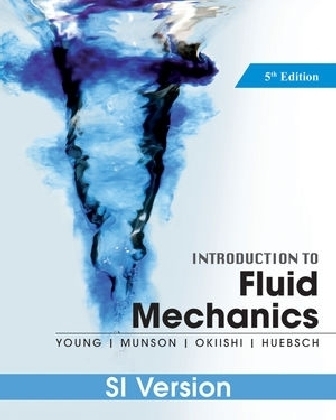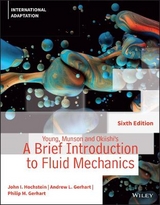
Introduction To Fluid Mechanics
John Wiley & Sons Inc (Verlag)
978-0-470-90215-8 (ISBN)
- Titel erscheint in neuer Auflage
- Artikel merken
An Introduction to Fluid Mechanics, SI Version 5th Edition is designed to cover the standard topics in a basic fluid mechanics course in a streamlined manner that meets the learning needs of today’s student. This books approach helps students connect the math and theory to the physical world and practical applications and apply these connections to solving problems. The text lucidly presents basic analysis techniques and addresses practical concerns and applications, such as pipe flow, open-channel flow, flow measurement, and drag and lift.
It offers a strong visual approach with photos, illustrations, and videos included in the text, examples and homework problems to emphasize the practical application of fluid mechanics principles.
1 INTRODUCTION 1
1.1 Some Characteristics of Fluids 3
1.2 Dimensions, Dimensional Homogeneity, and Units 3
1.2.1 Systems of Units 6
1.3 Analysis of Fluid Behavior 9
1.4 Measures of Fluid Mass and Weight 9
1.4.1 Density 9
1.4.2 Specific Weight 10
1.4.3 Specific Gravity 10
1.5 Ideal Gas Law 11
1.6 Viscosity 12
1.7 Compressibility of Fluids 17
1.7.1 Bulk Modulus 17
1.7.2 Compression and Expansion of Gases 18
1.7.3 Speed of Sound 19
1.8 Vapor Pressure 21
1.9 Surface Tension 21
1.10 A Brief Look Back in History 24
1.11 Chapter Summary and Study Guide 27
Review Problems 28
Problems 28
2 FLUID STATICS 32
2.1 Pressure at a Point 33
2.2 Basic Equation for Pressure Field 34
2.3 Pressure Variation in a Fluid at Rest 36
2.3.1 Incompressible Fluid 36
2.3.2 Compressible Fluid 38
2.4 Standard Atmosphere 39
2.5 Measurement of Pressure 39
2.6 Manometry 42
2.6.1 Piezometer Tube 42
2.6.2 U-Tube Manometer 43
2.6.3 Inclined-Tube Manometer 46
2.7 Mechanical and Electronic Pressure-Measuring Devices 47
2.8 Hydrostatic Force on a Plane Surface 47
2.9 Pressure Prism 52
2.10 Hydrostatic Force on a Curved Surface 54
2.11 Buoyancy, Flotation, and Stability 57
2.11.1 Archimedes’ Principle 57
2.11.2 Stability 59
2.12 Pressure Variation in a Fluid with Rigid-Body Motion 60
2.13 Chapter Summary and Study Guide 60
References 61
Review Problems 62
Problems 62
3 ELEMENTARY FLUID DYNAMICS—THE BERNOULLI EQUATION 68
3.1 Newton’s Second Law 69
3.2 F ma Along a Streamline 70
3.3 F ma Normal to a Streamline 74
3.4 Physical Interpretation 75
3.5 Static, Stagnation, Dynamic, and Total Pressure 78
3.6 Examples of Use of the Bernoulli Equation 81
3.6.1 Free Jets 81
3.6.2 Confined Flows 82
3.6.3 Flowrate Measurement 89
3.7 The Energy Line and the Hydraulic Grade Line 92
3.8 Restrictions on the Use of the Bernoulli Equation 94
3.9 Chapter Summary and Study Guide 95
Review Problems 96
Problems 97
4 FLUID KINEMATICS 102
4.1 The Velocity Field 103
4.1.1 Eulerian and Lagrangian Flow Descriptions 105
4.1.2 One-, Two-, and Three-Dimensional Flows 105
4.1.3 Steady and Unsteady Flows 106
4.1.4 Streamlines, Streaklines, and Pathlines 107
4.2 The Acceleration Field 110
4.2.1 The Material Derivative 110
4.2.2 Unsteady Effects 112
4.2.3 Convective Effects 113
4.2.4 Streamline Coordinates 114
4.3 Control Volume and System Representations 115
4.4 The Reynolds Transport Theorem 116
4.4.1 Derivation of the Reynolds Transport Theorem 116
4.4.2 Selection of a Control Volume 120
4.5 Chapter Summary and Study Guide 120
References 121
Review Problems 121
Problems 121
5 FINITE CONTROL VOLUME ANALYSIS 125
5.1 Conservation of Mass—The Continuity Equation 126
5.1.1 Derivation of the Continuity Equation 126
5.1.2 Fixed, Nondeforming Control Volume 127
5.1.3 Moving, Nondeforming Control Volume 131
5.2 Newton’s Second Law—The Linear Momentum and Moment-of-Momentum Equations 133
5.2.1 Derivation of the Linear Momentum Equation 133
5.2.2 Application of the Linear Momentum Equation 134
5.2.3 Derivation of the Moment-of-Momentum Equation 144
5.2.4 Application of the Moment-of-Momentum Equation 145
5.3 First Law of Thermodynamics—The Energy Equation 152
5.3.1 Derivation of the Energy Equation 152
5.3.2 Application of the Energy Equation 154
5.3.3 Comparison of the Energy Equation with the Bernoulli Equation 157
5.3.4 Application of the Energy Equation to Nonuniform Flows 162
5.4 Chapter Summary and Study Guide 164
Review Problems 166
Problems 166
6 DIFFERENTIAL ANALYSIS OF FLUID FLOW 175
6.1 Fluid Element Kinematics 176
6.1.1 Velocity and Acceleration Fields Revisited 176
6.1.2 Linear Motion and Deformation 177
6.1.3 Angular Motion and Deformation 179
6.2 Conservation of Mass 182
6.2.1 Differential Form of Continuity Equation 182
6.2.2 Cylindrical Polar Coordinates 184
6.2.3 The Stream Function 185
6.3 Conservation of Linear Momentum 188
6.3.1 Description of Forces Acting on Differential Element 189
6.3.2 Equations of Motion 191
6.4 Inviscid Flow 192
6.4.1 Euler’s Equations of Motion 192
6.4.2 The Bernoulli Equation 193
6.4.3 Irrotational Flow 195
6.4.4 The Bernoulli Equation for Irrotational Flow 196
6.4.5 The Velocity Potential 196
6.5 Some Basic, Plane Potential Flows 199
6.5.1 Uniform Flow 201
6.5.2 Source and Sink 201
6.5.3 Vortex 203
6.5.4 Doublet 207
6.6 Superposition of Basic, Plane Potential Flows 209
6.6.1 Source in a Uniform Stream—Half-Body 209
6.6.2 Flow around a Circular Cylinder 212
6.7 Other Aspects of Potential Flow Analysis 219
6.8 Viscous Flow 219
6.8.1 Stress–Deformation Relationships 219
6.8.2 The Navier–Stokes Equations 220
6.9 Some Simple Solutions for Laminar, Viscous, Incompressible Fluids 221
6.9.1 Steady, Laminar Flow between Fixed Parallel Plates 222
6.9.2 Couette Flow 224
6.9.3 Steady, Laminar Flow in Circular Tubes 227
6.10 Other Aspects of Differential Analysis 229
6.11 Chapter Summary and Study Guide 230
References 232
Review Problems 232
Problems 232
7 SIMILITUDE, DIMENSIONAL ANALYSIS, AND MODELING 238
7.1 Dimensional Analysis 239
7.2 Buckingham Pi Theorem 240
7.3 Determination of Pi Terms 241
7.4 Some Additional Comments about Dimensional Analysis 246
7.4.1 Selection of Variables 247
7.4.2 Determination of Reference Dimensions 247
7.4.3 Uniqueness of Pi Terms 247
7.5 Determination of Pi Terms by Inspection 248
7.6 Common Dimensionless Groups in Fluid Mechanics 249
7.7 Correlation of Experimental Data 250
7.7.1 Problems with One Pi Term 251
7.7.2 Problems with Two or More Pi Terms 252
7.8 Modeling and Similitude 254
7.8.1 Theory of Models 254
7.8.2 Model Scales 258
7.8.3 Distorted Models 259
7.9 Some Typical Model Studies 260
7.9.1 Flow through Closed Conduits 260
7.9.2 Flow around Immersed Bodies 262
7.9.3 Flow with a Free Surface 264
7.10 Chapter Summary and Study Guide 267
References 268
Review Problems 269
Problems 269
8 VISCOUS FLOW IN PIPES 274
8.1 General Characteristics of Pipe Flow 275
8.1.1 Laminar or Turbulent Flow 275
8.1.2 Entrance Region and Fully Developed Flow 277
8.2 Fully Developed Laminar Flow 278
8.2.1 From F ma Applied Directly to a Fluid Element 278
8.2.2 From the Navier–Stokes Equations 282
8.3 Fully Developed Turbulent Flow 282
8.3.1 Transition from Laminar to Turbulent Flow 283
8.3.2 Turbulent Shear Stress 284
8.3.3 Turbulent Velocity Profile 285
8.4 Dimensional Analysis of Pipe Flow 285
8.4.1 Major Losses 286
8.4.2 Minor Losses 290
8.4.3 Noncircular Conduits 298
8.5 Pipe Flow Examples 299
8.5.1 Single Pipes 300
8.5.2 Multiple Pipe Systems 307
8.6 Pipe Flowrate Measurement 309
8.7 Chapter Summary and Study Guide 313
References 314
Review Problems 315
Problems 315
9 FLOW OVER IMMERSED BODIES 321
9.1 General External Flow Characteristics 322
9.1.1 Lift and Drag Concepts 322
9.1.2 Characteristics of Flow Past an Object 325
9.2 Boundary Layer Characteristics 328
9.2.1 Boundary Layer Structure and Thickness on a Flat Plate 328
9.2.2 Prandtl/Blasius Boundary Layer Solution 330
9.2.3 Momentum Integral Boundary Layer Equation for a Flat Plate 332
9.2.4 Transition from Laminar to Turbulent Flow 334
9.2.5 Turbulent Boundary Layer Flow 336
9.2.6 Effects of Pressure Gradient 338
9.3 Drag 341
9.3.1 Friction Drag 342
9.3.2 Pressure Drag 342
9.3.3 Drag Coefficient Data and Examples 343
9.4 Lift 357
9.4.1 Surface Pressure Distribution 357
9.4.2 Circulation 361
9.5 Chapter Summary and Study Guide 363
References 364
Review Problems 364
Problems 364
10 OPEN-CHANNEL FLOW 370
10.1 General Characteristics of Open-Channel Flow 370
10.2 Surface Waves 371
10.2.1 Wave Speed 372
10.2.2 Froude Number Effects 374
10.3 Energy Considerations 374
10.3.1 Specific Energy 375
10.4 Uniform Depth Channel Flow 378
10.4.1 Uniform Flow Approximations 378
10.4.2 The Chezy and Manning Equations 378
10.4.3 Uniform Depth Examples 381
10.5 Gradually Varied Flow 385
10.6 Rapidly Varied Flow 386
10.6.1 The Hydraulic Jump 386
10.6.2 Sharp-Crested Weirs 390
10.6.3 Broad-Crested Weirs 393
10.6.4 Underflow Gates 395
10.7 Chapter Summary and Study Guide 397
References 398
Review Problems 398
Problems 398
11 TURBOMACHINES 403
11.1 Introduction 404
11.2 Basic Energy Considerations 404
11.3 Basic Angular Momentum Considerations 408
11.4 The Centrifugal Pump 410
11.4.1 Theoretical Considerations 410
11.4.2 Pump Performance Characteristics 414
11.4.3 System Characteristics and Pump Selection 416
11.5 Dimensionless Parameters and Similarity Laws 419
11.5.1 Specific Speed 422
11.6 Axial-Flow and Mixed-Flow Pumps 423
11.7 Turbines 426
11.7.1 Impulse Turbines 427
11.7.2 Reaction Turbines 433
11.8 Compressible Flow Turbomachines 436
11.9 Chapter Summary and Study Guide 437
References 438
Review Problems 439
Problems 439
A COMPUTATIONAL FLUID DYNAMICS AND FLOWLAB 443
B PHYSICAL PROPERTIES OF FLUIDS 458
C PROPERTIES OF THE U.S. STANDARD ATMOSPHERE 463
D REYNOLDS TRANSPORT THEOREM 465
E COMPREHENSIVE TABLE OF CONVERSION FACTORS 470
ONLINE APPENDIX LIST 474
| Verlagsort | New York |
|---|---|
| Sprache | englisch |
| Maße | 201 x 255 mm |
| Gewicht | 898 g |
| Themenwelt | Naturwissenschaften ► Physik / Astronomie ► Strömungsmechanik |
| Technik ► Bauwesen | |
| Technik ► Maschinenbau | |
| ISBN-10 | 0-470-90215-9 / 0470902159 |
| ISBN-13 | 978-0-470-90215-8 / 9780470902158 |
| Zustand | Neuware |
| Haben Sie eine Frage zum Produkt? |
aus dem Bereich



